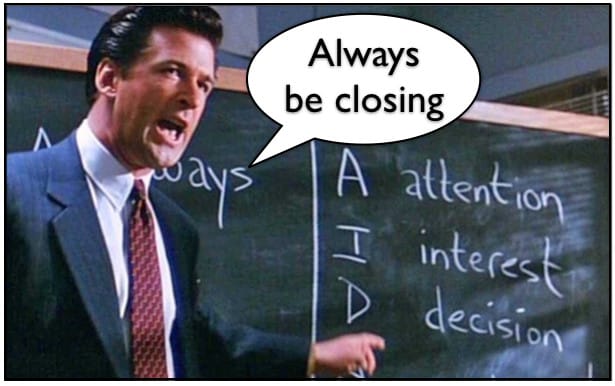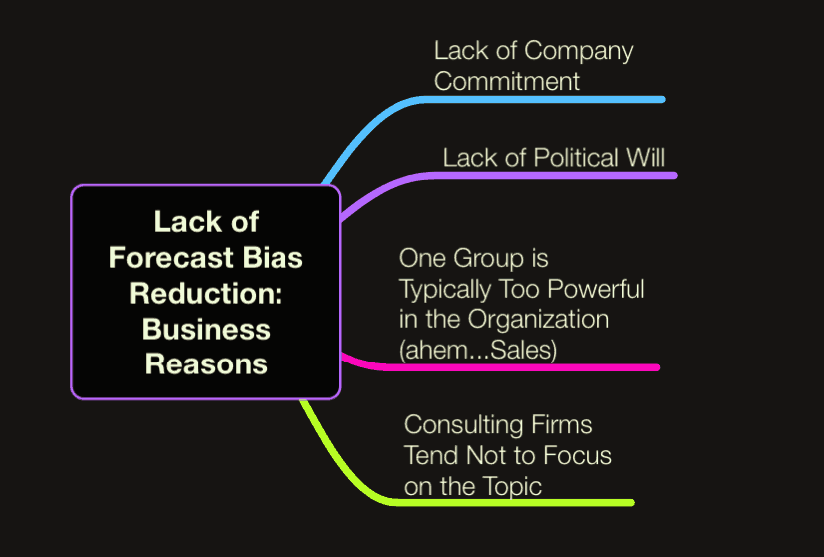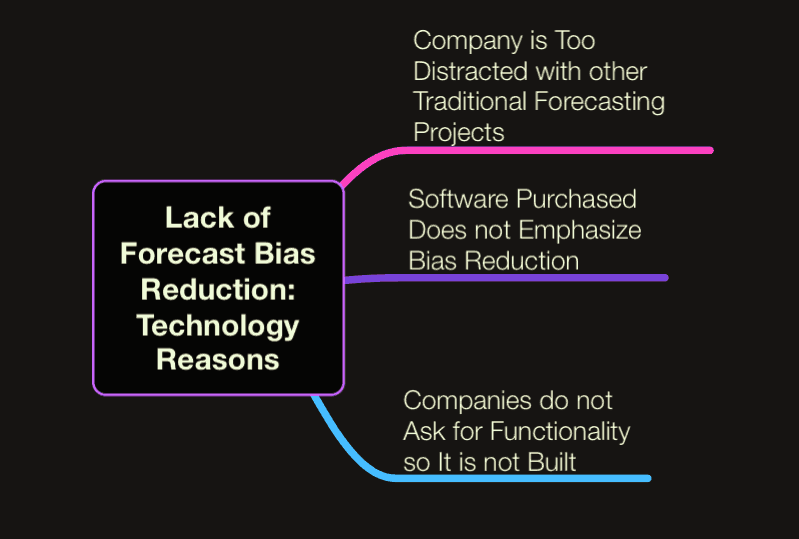A Frank Analysis of Deliberate Sales Forecast Bias
Executive Summary
- Forecast bias is often discussed without stating how it is deliberate.
- Sales forecasting, along with marketing forecasting, has the highest deliberate bias.

Introduction
Before writing this article, I spent time reading some of the many articles on sales forecasting right here on LinkedIn. Almost all of the articles I read were from people that most likely had many years of sales forecasting experience. Of course, the articles were not all the same, but there were strong similarities between them, similarities that can tell one quite a bit about how sales forecasting is often discussed.
Our References for This Article
If you want to see our references for this article and related Brightwork articles, visit this link.
The Different Issues
- Technology Focus: Often, the article would focus on making sales forecasting a priority or providing the right tools, etc..
- Focus on Unintentional Forecast Errors: Many articles focused on honest mistakes on the part of salespeople and were therefore focused on the competence, interest in entering forecasts, or support given to salespeople.
- Administrative Focus: The articles not only tended to leave out deliberate forecast inaccuracy. They also propose that the common problem of sales forecast accuracy is solvable through attention to various details such as improving communications, having a more structured process, etc. That is, there was very little if any discussion or coverage around the embedded incentives of salespeople.
A Different Type of Sales Forecasting Article
In this article, I want to discuss the far less covered and the intractable problem that belies sales forecast, and that is intentionally biased sales forecasts. This is where sales forecasts are knowingly made inaccurate based upon institutional incentives. This is sometimes acknowledged in a limited way through the use of the term “sandbagging.”
Sandbagging Versus Many Other Issues
Sandbagging is where a salesperson provides an inaccurate forecast due to his forecast being used as the salesperson’s quota — so that he can then exceed the quota. However, sandbagging is only the tip of the iceberg when it comes to deliberate forecast bias.
Forecast Bias Definition
Let us make sure that we are on the same page concerning the term forecast bias. Forecast bias is when a forecast is consistently inaccurate in one direction, either higher or lower than the actual forecast. An estimate can have zero bias but also may still be highly inaccurate. However, the number of times and the degree to which it is higher than the actual outcome is more or less balanced when the forecast is lower than the actual outcome. Therefore, bias is the degree of forecast error direction and not an overall measurement for forecast error.
The Importance of Forecast Bias to Understanding Sales Forecasting
Forecast bias is one of the essential topics of forecasting generally, but sales forecasting especially, but also one of the least discussed. This is nowhere more true than from the perspective of purposeful bias.
Assigning the Blame for Forecast Bias Between the Individual Versus the Institution
There is a strong tendency to place any focus on deliberate forecast bias on the individual.
However, it should be remembered that the individual is responding to institutional incentives. As institutions control the incentives they create, the first directive taken in reducing forecast bias should be to arrange their incentives in a way that does not promote forecast bias. As will be discussed, this is only very rarely done in practice.
Deliberate Sales Forecast Bias
It is well known that sales forecasts have the highest bias of any of the forecasts that are provided within a company.
In some cases, a sales forecast is blended with a statistical forecast, such as when forecasting toothpaste sales. Still, in the case of more significant ticket items, such as with the forecast of enterprise software sales, the sales forecast is often the only forecast used to generate the final forecast. The problem in almost all sales forecasts is that because the number of their sales typically compensates salespeople, and the salesperson’s job depends on their sales, salespeople have a strong institutional created bias to their forecast.
When Quotas Meet The Limitations of Market Demand
Companies most often place a higher quota that can be met due to market constraints (at least on all of the salespeople as a group). Just about every company wishes to sell more products than the market can absorb.
This means that the company turns over a portion of its sales team every year. As every salesperson knows, there are a limited number of good leads that are available. One part of making a quota is sales acumen, and another part is who gets access to the good leads, the Glengarry leads…

Ahhhh…the Glengarry Leads!
This is the plot of the movie Glengarry Glen Ross, the play adapted into a film and probably the best-known film ever made in the US on how the internals of sales works.
Alec Baldwin performs in what is a highly referenced scene by many sales departments in the US, and probably outside of the US, where his character aggressively and disrespectfully lectures the sales team consisting of Ed Harris, Jack Lemmon, and Alan Arkin as to who deserves the good leads:
These are the GlenGarry leads. And to you they are gold, and you don’t get them. Why? Because to give them to you is just throwing them away…..They are for closers.
Glengarry Glen Ross is set in real estate sales, which is a low-volume sales environment. However, high volume sales environments (i.e., selling toothpaste) face similar constraints in that there are a limited number of good customers, a limited amount of shelf space at retailers, etc.. Sales is a competition to move one’s product or service into a limited market. All companies want to grow faster than their overall market, but obviously, all can’t do this. Those salespeople that meet or exceed quotas are financially rewarded and obtain job security. Those that do not get lower rewards and often have to find new jobs. As Alec Baldwin’s character says:
“Do you know that it takes to sell real estate? It takes brass balls to sell real estate.”

Alec Baldwin plays a hyper-motivated top salesperson in Glengarry Glen Ross, who does not fully appreciate market demand limitations. Hyper motivation of this type does not dovetail well with forecast accuracy.
The Universal Nature of Sales Forecast Bias
There are several reasons for forecast bias. However, the deliberate type of bias I am referring to in this article exists in judgment forecasts (i.e., human rather than machine-generated forecasts) whenever any incentive, financial or otherwise, exists to produce a particular forecast. This problem can be found in just about any industry. Still, some of the most extreme examples come from the financial services industry, which is why I will use one example from the financial services industry to illustrate this point.
- How the Bond Rating System Works: The rating agencies like Moody’s and Standard and Poor’s rate financial instruments. What they are doing is providing what is nothing more than a forecast in return for money, as the rating is a “forecast” of whether the instrument will pay out a rate of return versus ceasing to pay the return at some point in the future. These forecasts have meaning because investors respect rating agencies.
- The Incentives for Bias: These rating agencies are incentivized to provide a more favorable rating or a forecast of future performance because they are paid by the companies that intend to sell the instrument. This means they want the best possible rating to sell the instrument for the highest reasonable price.
Even after the financial crisis of 2008, this system was never changed, so we have the same system (in the US in any case) to this day. This type of forecast bias exists throughout the US financial system, making the overall system unstable. There are so many different forecasts that are so heavily biased by financial incentives.
The Importance of Forecast Weighting
One of the key learnings of the book “Demand-Driven Forecasting” is that consensus based forecasting must have a structured process around it to be successful. What this means is that the collaborative forecasts must be weighed according to their long-term accuracy. It is a critical component to managing the bias in forecasts based on the incentives of different groups within the company.
Sales Forecasts
According to Charles Chase, the sales forecast typically has the highest degree of bias and is the least accurate. This is primarily because the sales group is compensated based on their ability to meet the quota based on their forecast. Marketing often has the opposite bias as they want to think the market opportunities are more significant than they are.
In his book, he recommends that the weight the sales forecasting should receive greatly depends on the following..
The key to success is to ask the sales and marketing departments to look at macro trends in the marketplace by account and channel and hold them accountable for measuring and improving forecast accuracy. In some industries where there is a great deal of available upstream data (consumer packaged goods, apparel and automotive manufacturing), the sales department will have less input, with the marketing department having more input. However, in industries where upstream data are limited (telecommunications, heavy manufacturing, and semiconductor); the sales department will play a key role in the demand driven forecasting process. – Demand Driven Forecasting
Salespeople are not measured on their forecast accuracy, only quota attainment. The amount of inventory carried by his company is not his problem. He does get highly irate if his product is not in stock at a 99% service level.
The Bias of Sales Forecasts
Sales forecasting has the highest bias of any forecast generated in any department within a company. The following quotation is instructive on this topic:
“Political pressures within organizations affect sales force composite forecasts because of a lack of understanding of the difference between sales forecasting and setting sales quotas. A sales forecast should be a realistic prediction of product sales for a certain interval of time given a set of assumptions regarding the environment. A sales quota is a motivational tool that assigns a portion of required revenues to each sales region and salesperson. Sales quotas and sales forecasts developed by the sales function should be developed with these differences in mind.” – Sales Forecasting Management
The Lacking Mathematical Support
Salespeople and brand managers are often not provided with the training to efficiently convert their market intelligence into useful adjustments to the forecast. Merely being a salesperson is not proper training in producing a quality forecast. I am amazed that salespeople are not provided with a quantitative analyst to translate their market intelligence to numbers.
Forecast Bias Definition
Let us make sure that we are on the same page on the term forecast bias. Forecast bias is when a forecast is consistently inaccurate in one direction, either higher or lower than the actual forecast. A forecast can have zero bias but also may still be highly inaccurate. Yet, the number of times and the degree to which it is higher than the actual outcome is more or less balanced when the forecast is lower than the actual result. Therefore, bias is the degree of forecast error direction and not an overall measurement of forecast error.
Forecast bias is one of the essential topics of forecasting and one of the least discussed, and this is nowhere more true than from the perspective of purposeful bias.
The Layers of Sales Forecasting at Companies
Sales forecasts are performed both by salespeople as well as by people that manage other salespeople. In other articles on sales forecast bias, there is often a line of thinking presented that while the salespeople may submit a biased sales forecast, the Sales Directors and VP’s are motivated to reduce this forecast bias. This happens to be the overall reasoning for the application created by Right90. This is one of the few applications that allows the buyer to identify and adjust forecast bias, and it is entirely focused on sales forecasting.
A Correct Assumption?
Years ago, I was enthusiastic about the Right90 application until I became more experienced in sales forecasting and realized that this application contains an assumption. And this assumption is that Directors and VPs of sales want to decrease forecast bias.
Is this assumption actually, in many cases, not correct?
The reason is easy to understand. The managers of salespeople areas subject to having their careers negatively impacted by not presenting an appropriately rosy picture to their higher-ups, in the same way, that the salespeople are.
If a salesperson or sales director generates a realistic forecast, someone who can provide a more accurate forecast to the higher-ups’ liking may replace them.
And this is the problem with the assumption that those that manage salespeople necessarily have an incentive to neutralize their sales forecast bias. To understand why, let us first layout the naïve hypothesis, one that one might make if one had not seen how sales processes tend to work.
The Naive Hypothesis
Under this hypothesis, sales management would have to have an incentive to reduce sales forecast bias. Because if they do not, then the salespeople, more often than not, will end up not meeting their quota for the quarter, in which sales management would then be held accountable.
The reality of how sales forecasting works is quite a bit different from this, and while the naive hypothesis “seems to make sense,” in fact, it does not account for the reality of sales teams. And the reason the naive hypothesis is untrue has to do with some of the following factors:
Factor #1: Considering the Turnover in the Sales Organization
A company’s sales force, as well as the sales management, is filled with people that are in various stages of their career within the enterprise. The turnover at most businesses in sales is high when compared to other professions. Therefore it is widespread for a Director or VP of sales to be working with a new salesforce (if the Director or VP of Sales is unique to the company) or with new individuals within the sales force (when new salespeople join the sales force). Some of the salespeople will not be able to make their quota. Therefore they will have the incentive to continue to forecast that sales that have almost no probability to close are genuine opportunities to keep their pipeline looking healthy.
Factor #2: The Lifecycle of the Sales Person
The sales management may know that some salespeople have a small likelihood of closing much of their pipeline. However, if they remove the salesperson, they still have to find another one, and the new salesperson will take the time to bring it up. It is estimated that it takes 7 to 10 months for a new salesperson to become fully productive (on average). Therefore, sales management must decide if they are willing to replace an underperforming salesperson – with a new one, with the knowledge that they probably will more likely than not sell little for at least the first two quarters.
Factor #3: New Products or New Services
Any company will have sales in different product lines. As the company often has significant investments in the new product lines and wants the new product lines to be successful, as they see this as their growth. Sales management will often have promoted new products to their management.
All of this means that an incentive is necessary to accept having the product line underperform for a while.
Factor #4: The Lack of Forecast Accuracy Checking
Companies that sell high-volume items quite often track sales forecast accuracy, but few hold their salespeople accountable. This is a long-term and widespread problem, but I have yet to find a company that measured their salesforce’s forecast error.
Sales Management Setting the Sales Forecast
According to salespeople with which I have discussed this subject, in many cases, sales management sets or overrides the forecast values in the CRM system for their sales team. Sales management often gives the impression that the salespeople have added the sales forecasts. This brings up apparent problems in checking the forecast accuracy of the forecasts that the actual salespeople produce. This is an enormous faux pas that would not be accepted in other forecasting types, yet it is a matter of routine in sales forecasting.
Bias Reduction
Often consensus forecasting improvement is confused or mingled with bias reduction. This is a very significant error that undermines the understanding of CBF. Bias can be and most often is present in both the consensus side and the statistical forecasting side. The objective is to remove bias from both sides. However, very few companies do.
Why?
Below are listed both business and technology reasons why bias reduction does not tend to focus on companies.


Who is Focused on Bias Reduction?
I can say that most forecasting applications I have come across do not have forecast bias adjustment workflow built into them. This workflow is essential because the software must provide an easy and systematic way of reducing bias.
Up to this point, the most advanced in this regard that I had seen were the consensus based vendors Inkling Markets and Consensus Point.
The Sales Pipeline
The sales pipeline is the primary sales forecast. The sales pipeline is not set by the salesperson but by sales management, and when compared to other types of forecasting, this is incredibly strange.
The reason it is so weird is that the sales pipeline (or the “initial forecast”) is a goal and part of the objectives that the company would like to meet. The sales pipeline is a forecast that the sales manager does not need to match, and it is the sales pipeline that someone else needs to meet. Of course, sales management must attain some combined sales pipeline for its salespeople. This won’t typically be achieved because only a little over half of the salespeople meet their sales pipeline. So some of the salespeople will not meet their sales pipeline without necessarily affecting sales management.
Let consider a VP of sales that works with the CEO to set sales pipelines for the year. Both the CEO and VP of sales want the sales pipelines to set high. And because they don’t have to meet the quotas, there is little to moderate them from fixing the quota at a high level. The salespeople have to meet the quota, as they keep their job if they meet the quota. Therefore, there is an apparent conflict between sales management and salespeople regarding the quota. A forecast should not be a goal. For instance, if someone is asked how much money they would like to make in a year, you will get one number, which is different from what they think they will make in a year.
Quota setting blurs the line between what is desired and what is a forecast. That is the heart of the problem. This is why there is a significant bias in the vast majority of quotas unless they are set through some highly structured process, which separates the forecast’s desire.
The Effect of the Sales Pipeline on Forecast Accuracy
Sales quotas are typically set too high, which is demonstrated both by the percentage of salespeople that meet quotas combined with an analysis as to how sales quotas are set.
Sales management will often feel satisfied with their quotas because they give their salespeople “stretch goals.”
Not all stretch goals are motivational. If goals are set to the point where they are unattainable, the goal will often become de-motivational. The effect of de-motivation of stretch goals is nearly always ignored as a problematic outcome. For example, experience mountain climbers set attainable goals for themselves regarding the progress that they will make per day. They don’t set stretch goals, as the stretch goal can typically only be met by circumventing safety controls.
This also has an unavoidable negative impact on forecast accuracy. Each salesperson (except for those who are the top salespeople and are having good quarters) promotes the salesperson not to qualify out of opportunities and keeps customers with a low probability of closing in the forecast. This affects the average or below average salespeople because when top salespeople exceed their quota, they also tend to have their quota raised the following year.
Much of the game playing that occurs in the communication between sales and sales management, much of the bad data in CRM systems can be attributed to a lack of reality regarding the first part of the sales management process, which is the quota setting.
Conclusion
Having analyzed many different areas of judgment-based forecasting where incentives have created that cause a bias in the forecaster for a book I wrote on Combining the Sales and Statistical Forecast. There is a common and repeating theme of expecting unbiased forecasts from individuals that have an incentive to produce biased forecasts. Interestingly the knowledge that these forecasts are biased does not lead to adjustments being made to these judgment forecast methods. Therefore, nothing or close to nothing is learned from history used to improve a flawed process.
Very few companies have a method for measuring the forecast error of different groups and gradually updating their input to the overall forecast based upon previous forecast accuracy.